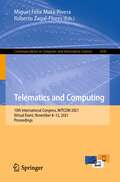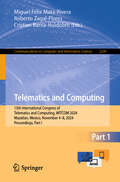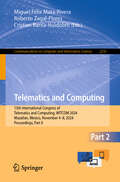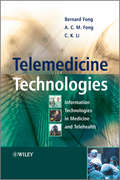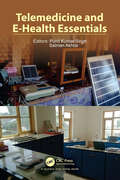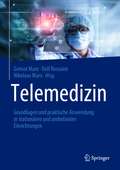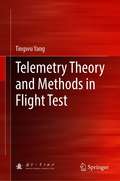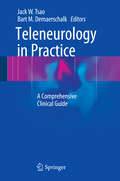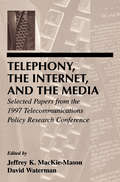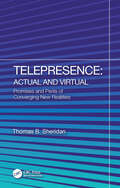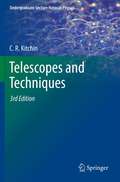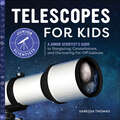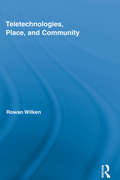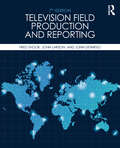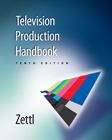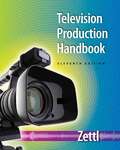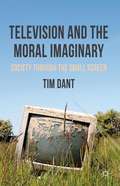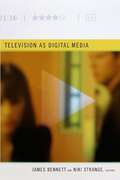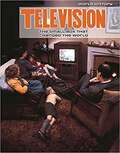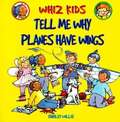- Table View
- List View
Telematics and Computing: 10th International Congress, WITCOM 2021, Virtual Event, November 8–12, 2021, Proceedings (Communications in Computer and Information Science #1430)
by Roberto Zagal-Flores Miguel Félix Mata-RiveraThis book constitutes the thoroughly refereed proceedings of the 10th International Congress on Telematics and Computing, WITCOM 2021, held in November 2021. Due to the COVID-19 pandemic the conference was held online. The 12 full papers and 7 short papers in this volume were carefully reviewed and selected from 48 submissions. The papers are focused on the topics of deep and machine learning, cybersecurity, wireless networks, computer vision, communications, and education applied to different sceneries of study and COVID-19.
Telematics and Computing: 13th International Congress of Telematics and Computing, WITCOM 2024, Mazatlan, Mexico, November 4–8, 2024, Proceedings, Part I (Communications in Computer and Information Science #2249)
by Roberto Zagal-Flores Miguel Félix Mata-Rivera Cristian Barria-HuidobroThis two-volume set constitutes the refereed proceedings of the 13th International Conference on Telematics and Computing , WITCOM 2024, which took place in Mazatlan, Mexico, during November 4–8, 2024. The 41 full papers presented in this volume were carefully reviewed and selected from 91 submissions. The papers focus on the topics of environment monitoring, information systems, IoT, education, artificial intelligence techniques, cybersecurity, data science, and energy, with applications to different case of study.
Telematics and Computing: 13th International Congress of Telematics and Computing, WITCOM 2024, Mazatlan, Mexico, November 4–8, 2024, Proceedings, Part II (Communications in Computer and Information Science #2250)
by Roberto Zagal-Flores Miguel Félix Mata-Rivera Cristian Barria-HuidobroThis two-volume set constitutes the refereed proceedings of the 13th International Conference on Telematics and Computing , WITCOM 2024, which took place in Mazatlan, Mexico, during November 4–8, 2024. The 41 full papers presented in this volume were carefully reviewed and selected from 91 submissions. The papers focus on the topics of environment monitoring, information systems, IoT, education, artificial intelligence techniques, cybersecurity, data science, and energy, with applications to different case of study.
Telemedicine Technologies
by C. K. Li Bernard Fong A.C.M. FongThis book brings together a broad range of topics demonstrating how information and wireless technologies can be used in healthcareIn this book, the authors focus on how medical information can be reliably transmitted through wireless communication networks. It explains how they can be optimized to carry medical information in various situations by utilizing readily available traditional wireless local area network (WLAN) and broadband wireless access (BWA) systems. In addition, the authors discuss consumer healthcare technology, which is becoming more popular as reduction in manufacturing cost of electronics products makes healthcare products more affordable to the general public. Finally, the book explores topics such as communication networks and services, patient monitoring, information processing, system deployment, data security and privacy, information technology in alternative medicine, multimedia and health informatics, and caring for the community. Key Features:Focuses on the transmission of medical information over wireless communication networks, and addresses topics such as communication networks and services, patient monitoring, information processing, system deployment, data security and privacy, and many others Provides an in-depth introduction to the various factors that need to be considered for supporting healthcare services with information technology Covers advancements in topics such as RFID in healthcare Discusses medical signal processing as well as ECG and signal processing techniques This book will be of interest to advanced students and professors in biomedical engineering, bioinformatics, and information engineering. Medical and IT professionals involved in specifying new facilities, healthcare practitioners in telemedicine, researchers in wireless communications and information technology, and network administrators will also find this book insightful.
Telemedicine and E-Health Essentials
by Salman Akhtar Punit Kumar SinghTelemedicine and E-Health Essentials presents a comprehensive analysis of virtual healthcare systems transforming modern medicine. From basic telephone consultations to advanced digital platforms, this book explores how remote healthcare technologies are improving medical access and patient outcomes. Through evidence-based examples, it examines successful applications in emergency care, specialist consultations, and remote monitoring while addressing key implementation challenges in data security, provider training, and regulatory compliance. The COVID-19 pandemic's influence on accelerating virtual care adoption is analyzed with practical insights. This essential resource guides healthcare administrators, clinicians, and policymakers in optimizing telemedicine integration for enhanced healthcare delivery.
Telemedicine and Electronic Medicine
by Halit Eren and John G. WebsterThe E-Medicine, E-Health, M-Health, Telemedicine, and Telehealth Handbook provides extensive coverage of modern telecommunication in the medical industry, from sensors on and within the body to electronic medical records and beyond. Telemedicine and Electronic Medicine is the first volume of this handbook. Featuring chapters written by leading experts and researchers in their respective fields, this volume: Describes the integration of—and interactions between—modern eMedicine, telemedicine, eHealth, and telehealth practices Explains how medical information flows through wireless technologies and networks, emphasizing fast-deploying wireless body area networks Presents the latest developments in sensors, devices, and implantables, from medical sensors for mobile communication devices to drug-delivery systems Illustrates practical telemedicine applications in telecardiology, teleradiology, teledermatology, teleaudiology, teleoncology, acute care telemedicine, and more The E-Medicine, E-Health, M-Health, Telemedicine, and Telehealth Handbook bridges the gap between scientists, engineers, and medical professionals by creating synergy in the related fields of biomedical engineering, information and communication technology, business, and healthcare.
Telemedicine: A Guide to Assessing Telecommunications in Health Care
by Committee on Evaluating Clinical Applications of TelemedicineTelemedicine--the use of information and telecommunications technologies to provide and support health care when distance separates the participants--is receiving increasing attention not only in remote areas where health care access is troublesome but also in urban and suburban locations.Yet the benefits and costs of this blend of medicine and digital technologies must be better demonstrated before today's cautious decisionmakers invest significant funds in its development.Telemedicine presents a framework for evaluating patient care applications of telemedicine. The book identifies managerial, technical, policy, legal, and human factors that must be taken into account in evaluating a telemedicine program. The committee reviews previous efforts to establish evaluation frameworks and reports on results from several completed studies of image transmission, consulting from remote locations, and other telemedicine programs.The committee also examines basic elements of an evaluation and considers relevant issues of quality, accessibility, and cost of health care.Telemedicine will be of immediate interest to anyone with interest in the clinical application of telemedicine.
Telemedizin: Grundlagen und praktische Anwendung in stationären und ambulanten Einrichtungen
by Rolf Rossaint Gernot Marx Nikolaus MarxDas vorliegende Buch gibt einen umfassenden Überblick über den aktuellen Stand und die Entwicklungen im Bereich der Telemedizin in Deutschland. Das Herausgeberteam aus einem der führenden Telemedizinzentren Deutschlands und ein interdisziplinäres Autorenteam liefern wesentliche Grundlagen sowie zahlreiche Anwendungsbeispiele aus dem stationären und ambulanten Bereich. Zudem werden Chancen und Risiken der Telemedizin erörtert, so dass der Leser gut für die Zukunft in Klinik oder Praxis gerüstet ist. Ein Grundlagen- und Nachschlagewerk für alle Ärzte, die sich für digitale Zukunft im Gesundheitswesen wappnen und ihre Patienten optimal versorgen möchten.
Telemetry Theory and Methods in Flight Test
by Tingwu YangThis book describes systematically telemetry theory and methods for aircraft in flight test. Test targets of telemetry in flight test include airplanes, helicopters, unmanned aerial vehicles, aerostatics, carrier-based aircraft, airborne equipment (systems), weapon systems, (powered) aircraft scale models, aircraft external stores (e.g., nacelle, auxiliary tanks), and ejection seats and so on. The book collects the author's telemetry research work and presents methods that have been verified in real-world tests. The book has eight chapters: the first three discuss the theoretical basis of telemetry, while the other five focus on the methods used in flight tests.Unlike other professional textbooks, this book describes the practical telemetry theory and combines theory and engineering practice to offer a comprehensive and systematic overview of telemetry in flight test for readers.
Teleneurology in Practice
by Jack W. Tsao Bart M. DemaerschalkThis title will provide an up-to-date review of the emerging practice of neurology telemedicine. Increasingly, neurology, like other disciplines of medicine, is implementing the technological advances and discoveries of the science of healthcare delivery to improve not only access and efficiency but outcomes and cost as well. For patients in remote and underserved areas, having a neurological condition means lengthy and costly travel to obtain specialist evaluation. Telemedicine has the ability to deliver such care to a patient's local community. Neurology telemedicine for acute stroke has already demonstrated clinical efficacy and cost effectiveness by raising the numbers of thrombolysis-eligible patients who can be treated in a timely fashion. More than 85% of leading US neurology departments currently use or plan to implement telemedicine within the next year. The US military has a limited number of neurologists - a store-and-forward consultation system has enabled military neurologists to deliver far-forward battlefield care for service members deployed overseas. The chapters in this book will review the use of telemedicine for the evaluation and treatment of patients with many common neurological conditions and will provide a practical guide for neurologists seeking to incorporate telemedicine into their daily practices.
Telephony, the Internet, and the Media: Selected Papers From the 1997 Telecommunications Policy Research Conference (LEA Telecommunications Series)
by Jeffrey K. MacKie-Mason David WatermanCommemorating the 25th anniversary of the Telecommunications Policy Research Conference (TPRC), this volume begins with a historical survey of a quarter-century of TPRC meetings as one measure of change in and research about the telecommunications industry. Additional papers reflecting the ongoing pace of change in technological, economic, and policy issues are organized around four topics: * economic analysis of local and international telephone policy; * media industry studies including video competition, guidelines for children's educational television, and the setting of AM stereo standards; * applications and policy regarding the Internet; and * comparative studies in telephone and satellite policy. Collectively, the contents of this volume assess key issues for scholars, policymakers, and practitioners. Research reported in this volume illustrates the continually expanding scope of scholarly concerns about the telecommunications and information industry and contributes to further policy research and analysis.
Telepresence: Promises and Perils of Converging New Realities
by Thomas B. SheridanTelepresence: Actual and Virtual explores the history of telepresence from the 1948 developments of master–slave manipulation, through to current telepresence technology used in space, undersea, surgery and telemedicine, operations in nuclear and other hazardous environments, policing and surveillance, agriculture, construction, mining, warehousing, education, amusement, social media, and other contexts. It also describes the various operator hand and body controls and the corresponding telerobotic actuation of robotic hands, arms, and locomotion. This book reviews the sensing and control technology, its history and likely future, and discusses the many research and policy issues that are raised. The book also takes up key questions relating to social and ethical issues, given that a person’s mechanical reach is becoming unlimited, enabling one to perform mischievous or harmful acts without identification, and what that portends for future developments in telepresence, including regulation and recommended directions of development. The primary audience for this book is professionals interested in human–robot interaction, human factors engineering, virtual reality, applications to space and undersea exploration, telemedicine and telesurgery, firefighting, mechanized agriculture, policing, drone surveillance, warehouse parts' fetching, mining, and military operations.
Telescopes and Space Probes (World Book's Solar System and Space Exploration Library)
by Kathleen KainIntroduction to telescopes and space probes for primary and intermediate grade students. Includes fun facts, glossary, resource list and index.
Telescopes and Techniques
by C. R. Kitchin"Telescopes and Techniques" has proved itself in its first edition, having become probably one of the most widely used astronomy texts, both for numerate amateur astronomers and for astronomy and astrophysics undergraduates. The first and second editions of the book were widely used as set texts for introductory practical astronomy courses in many universities. This book guides the reader through the mathematics, physics and practical techniques needed to use telescopes (from small amateur models to the larger instruments installed in many colleges) and to observe objects in the sky. Mathematics to around Advanced Placement standard (US) or A level (UK) is assumed, although High School Diploma (US) or GCSE-level (UK) mathematics plus some basic trigonometry will suffice most of the time. Most of the physics and engineering involved is described fully and requires no prior knowledge or experience. This is a 'how to' book that provides the knowledge and background required to understand how and why telescopes work. Equipped with the techniques discussed in this book, the observer will be able to operate with confidence his or her telescope and to optimize its performance for a particular purpose. In principle the observer could calculate his or her own predictions of planetary positions (ephemerides), but more realistically the observer will be able to understand the published data lists properly instead of just treating them as 'recipes.' When the observer has obtained measurements, he/she will be able to analyze them in a scientific manner and to understand the significance and meaning of the results. "Telescopes and Techniques, 3rd Edition" fills a niche at the start of an undergraduate astronomer's university studies, as shown by it having been widely adopted as a set textbook. This third edition is now needed to update its material with the many new observing developments and study areas that have come into prominence since it was published. The book concentrates on the knowledge needed to understand how small(ish) optical telescopes function, their main designs and how to set them up, plus introducing the reader to the many ways in which objects in the sky change their positions and how they may be observed. Both visual and electronic imaging techniques are covered, together with an introduction to how data (measurements) should be processed and analyzed. A simple introduction to radio telescopes is also included. Brief coverage of the most advanced topics of photometry and spectroscopy are included, but mainly to enable the reader to see some of the developments possible from the basic observing techniques covered in the main parts of the book.
Telescopes for Kids: A Junior Scientist's Guide to Stargazing, Constellations, and Discovering Far-Off Galaxies (Junior Scientists)
by Vanessa ThomasExplore the mysteries of the night sky with the Junior Scientists series for kids ages 6 to 9Scan the skies for 40 incredible sights with a book that shows budding scientists how to use a telescope for kids. You'll learn how to choose a telescope, set it up, and seek out the wonders of the Northern Hemisphere, from the Big Dipper to the Whirlpool Galaxy.Detailed visual guides—Illustrations of each star, planet, and more make them easier to spot— and once you can identify the major ones, you can use them to find others with any telescope for kids.Outer space school—Discover what time of year it's easiest to see different objects in the sky, the life cycle of a star, how galaxies are cataloged, and more!Fun facts—Find out where the constellations get their names and why looking at the stars means you're actually looking back in time!See what's happening out in the cosmos with this guide to making the most of a telescope for kids.
Teletechnologies, Place, and Community (Comedia)
by Rowan WilkenTeletechnologies, or technologies of distance, cannot be ignored. Indeed, the present electronic age is said to have wrought profound changes to how we think about and experience who we are, where we are, and how we relate with one another. Place and community have traditionally formed key concepts for thinking about these issues, but what relevance do these concepts now hold for us? In this wide-ranging study, Wilken re-evaluates how ideas of place and community intersect with and help us make sense of a world transformed by information and communication technologies. This interdisciplinary investigation ranges across diverse textual and contextual terrain, exploring approaches from media and communications, architectural history and theory, philosophy, sociology, geography, literature, and urban design. The rich analysis of these myriad texts reveals the complex and at times contradictory ways in which notions of place and community circulate in relation to these technologies of distance. Wilken’s examination underscores both the enduring importance of ideas of place and community in the present age, and the urgent need to continue to engage with, think about and reconfigure these twin ideas.
Television After TV: Essays on a Medium in Transition
by Lynn Spigel Jan OlssonIn the last ten years, television has reinvented itself in numerous ways. The demise of the U. S. three-network system, the rise of multi-channel cable and global satellite delivery, changes in regulation policies and ownership rules, technological innovations in screen design, and the development of digital systems like TiVo have combined to transform the practice we call watching tv. If tv refers to the technologies, program forms, government policies, and practices of looking associated with the medium in its classic public service and three-network age, it appears that we are now entering a new phase of television. Exploring these changes, the essays in this collection consider the future of television in the United States and Europe and the scholarship and activism focused on it. With historical, critical, and speculative essays by some of the leading television and media scholars, Television after TV examines both commercial and public service traditions and evaluates their dual (and some say merging) fates in our global, digital culture of convergence. The essays explore a broad range of topics, including contemporary programming and advertising strategies, the use of television and the Internet among diasporic and minority populations, the innovations of new technologies like TiVo, the rise of program forms from reality tv to lifestyle programs, television's changing role in public places and at home, the Internet's use as a means of social activism, and television's role in education and the arts. In dialogue with previous media theorists and historians, the contributors collectively rethink the goals of media scholarship, pointing toward new ways of accounting for television's past, present, and future. Contributors William Boddy Charlotte Brunsdon John T. Caldwell Michael Curtin Julie D'Acci Anna Everett Jostein Gripsrud John Hartley Anna McCarthy David Morley Jan Olsson Priscilla Pea Ovalle Lisa Parks Jeffrey Sconce Lynn Spigel William Uricchio
Television Field Production and Reporting: A Guide to Visual Storytelling
by Fred Shook John Larson John DeTarsioTelevision Field Production and Reporting provides a comprehensive introduction to the art of video storytelling. Endorsed by the National Press Photographers Association, this book focuses on the many techniques and tools available in today’s digital landscape, including how drones and miniaturized technology can enrich the storytelling process. The new edition of Television Field Production and Reporting is an absolute must in this visually oriented, rapidly changing field. At its core, visual storytelling helps transmit information, expose people to one another, and capture and communicate a sense of experience in unforgettable ways. This edition reflects, through practitioners' eyes, how to achieve those goals and excel as a professional, whatever the medium at hand, even as changing technology revises the storyteller’s toolkit. This edition emphasizes digital and emerging media, and includes new color photography relevant to contemporary visual storytelling and reporting. It also features important updates regarding digital media law which affect anyone who records and/or disseminates digital media content, whether in private, on television, the web, via social networking sites, or in commercial venues. The seventh edition of Television Field Production and Reporting stresses the mastery of innovative storytelling practices in video programming as far ranging as electronic press kits, multi-camera production, stylized programs, corporate video, raw documentaries, and real time cinéma vérité.
Television Production Handbook
by Herbert ZettlThis practical textbook explains the basic workings behind the television camera, studio lighting equipment, microphones, and the video recording system, then outlines the job duties performed by graphic designers, the technical crew, news production personnel, floor managers, producers, and directors. The ninth edition adds a section on high definition video. Annotation ©2005 Book News, Inc., Portland, OR (booknews.com)
Television Production Handbook
by Herbert ZettlIn Herbert Zettl's field-defining text TELEVISION PRODUCTION HANDBOOK, the author emphasizes how production proceeds in the digital age -- from idea to image -- and how it moves through the three major phases, from preproduction to production to postproduction. In this context, you will learn about the necessary tools, examine what they can and cannot do, and explore how they are used to ensure maximum efficiency and effectiveness. This edition also features the latest digital equipment and production techniques, including HDV and HDTV.
Television Production Handbook
by Herbert ZettlIn Herbert Zettl's field-defining text TELEVISION PRODUCTION HANDBOOK, the author emphasizes how production proceeds in the digital age -- from idea to image -- and how it moves through the three major phases, from preproduction to production to postproduction. In this context, you will learn about the necessary tools, examine what they can and cannot do, and explore how they are used to ensure maximum efficiency and effectiveness. This edition also features the latest digital equipment and production techniques, including HDV and HDTV.
Television and the Moral Imaginary
by Tim DantJust how bad is television? Drawing on a range of theoretical sources including Husserl Lacan, Lefebvre, Sartre, Schutz and Adam Smith, this book takes a phenomenological approach to the small screen to offer an original sociological approach to television and its contribution to moral culture of late modern societies.
Television as Digital Media
by James Bennett Niki StrangeIn Television as Digital Media, scholars from Australia, the United Kingdom, and the United States combine television studies with new media studies to analyze digital TV as part of digital culture. Taking into account technologies, industries, economies, aesthetics, and various production, user, and audience practices, the contributors develop a new critical paradigm for thinking about television, and the future of television studies, in the digital era. The collection brings together established and emerging scholars, producing an intergenerational dialogue that will be useful for anyone seeking to understand the relationship between television and digital media. Introducing the collection, James Bennett explains how television as digital media is a non-site-specific, hybrid cultural and technological form that spreads across platforms such as mobile phones, games consoles, iPods, and online video services, including YouTube, Hulu and the BBC's iPlayer. Television as digital media threatens to upset assumptions about television as a mass medium that has helped define the social collective experience, the organization of everyday life, and forms of sociality. As often as we are promised the convenience of the television experience "anytime, anywhere," we are invited to participate in communities, share television moments, and watch events live. The essays in this collection demonstrate the historical, production, aesthetic, and audience changes and continuities that underpin the emerging meaning of television as digital media. Contributors. James Bennett, William Boddy, Jean Burgess, John Caldwell, Daniel Chamberlain, Max Dawson, Jason Jacobs, Karen Lury, Roberta Pearson, Jeanette Steemers, Niki Strange, Julian Thomas, Graeme Turner
Television: The Small Box that Changed the World (World History)
by Katie KawaIt is sometimes said that we are living in a Golden Age of television. What does that mean, and how did we get there? Readers find the answers as they trace the history of television, from its invention to the current age of Peak TV. <p><p> This fascinating story is presented to readers through informative main text, annotated quotations, detailed sidebars, primary sources, and a comprehensive timeline. Television has changed nearly every aspect of life in many countries, and readers are sure to be excited by this fun and fact-filled look at how history and television have influenced each other.
